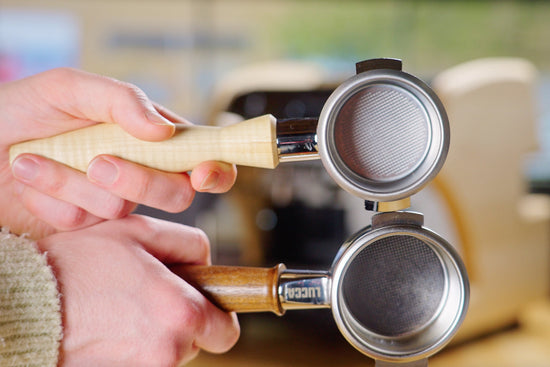Bigger Isn’t Always Better: Rethinking Basket Size

In a world where we all carry computers in our pockets, espresso gear has stayed surprisingly loyal to its roots. Take the E61 group head: it’s named after the year it was created, 1961. At its core, the E61 group head design has not changed, but there have been additional improvements, like introducing electronic heating elements to mitigate a long heat-stabilization time. While we're not taking a dig at tradition (some traditions do matter), it’s fair to wonder: are some of the industry’s holdovers preventing us from making better espresso? Have we plateaued?
One of those remnants is the classic 58mm basket. No one really has a solid explanation for why this size was standardized other than it worked. No espresso committee sat down one day and decided that 58mm would be the industry standard basket size. So, let's get critical: the 58mm basket is too wide. If you’ve ever chased the elusive perfect shot only to run into finicky channeling or uneven extractions, it’s fair to ask: could a narrower basket be better? It's also important to remember that the 58mm basket size was primarily adopted for commercial settings, where service speed was the top priority in the cafe rather than consistency or coffee quality.
Let’s test the SWORKS 49mm step-down basket and see why it could change the espresso game for the long term.
Smaller & With a Better Build

This is not your typical stamped OEM basket. The SWORKS 49mm basket is precision-machined from a kilogram of 17/4 stainless steel. That means it’s heavy—like flex-resistant heavy. When you’re pushing nine bars of pressure through a coffee puck, that sturdiness matters, which can prevent extraction issues like channeling and puck cracking.
The basket's straight sidewalls and a high-density hole pattern that reaches the edge ensure that extraction is maximized end-to-end. This design choice smartly improves flow distribution and helps reduce uneven extractions. One thing to note: while the floral pattern doesn't seem to contribute to any material changes, it sure does look cute and we're admittedly suckers for good design.
Moreover, the standout feature is that the 49mm step-down basket works in any 58mm bottomless portafilter. But what are the benefits of a smaller diameter basket?
It's All Physics

Narrowing the diameter of your basket has a few sneaky physics-based advantages. For one, the smaller exit area restricts flow a bit, meaning you can grind a touch coarser for the same espresso recipe. Thus, avoiding the over-extraction of ultra-fines can help reduce bitterness and astringency. All good in our book.
Deeper baskets also make the puck a better filter. As water travels through more coffee, there’s more resistance, slows things down and makes it harder for water to find those frustrating shortcuts that lead to channeling. This is a main reason why we’ve loved 53mm group heads from the beginning: you get much more control, better consistency, and often, a more forgiving extraction.
So while the 58mm basket certainly works (and works well), the 49mm option opens up more avenues for dialing in. Let's get into some taste testing that demystifies this wizardry and nails down some real-world material benefits.
Same Machine, Different Results

Here’s where it gets fun: because the SWORKS basket fits in a 58mm portafilter, you don’t have to commit to one or the other. Pull shots with a traditional 20g basket, then swap in the 49mm and see how it compares. Want to go deeper? If you have a refractometer, you can measure extraction yields and compare the difference head-to-head.
We pulled two 1:2 shots with the same recipe on the Profitec RIDE and Eureka Oro Single-Dose. One shot was pulled with a standard 58mm 20g basket, and one with the SWORKS 49mm step-down basket.
- Shot 1: 58mm basket: 26-second shot time at a 1:2 ratio (20g IN //40g OUT)
- Shot 2: 49mm step-down basket: also, around 26 seconds with a similar 1:2 ratio
The results: Both shots tasted decent, and the narrow basket produced a shot that tasted brighter, adding balance to the inherent bitterness of the coffee, really well. On the other hand, the standard 58mm shot has a richer and rounder mouthfeel, more akin to a traditional espresso; however, it is much more astringent. Surprisingly, a simple basket change made such a night-and-day difference in the shot's flavor profile, giving us a better appreciation of Kickstep, a darker roast with a more traditional flavor profile.
We’re not here to crown a new king, but having this kind of modularity opens the door to new experiments and, ultimately, better espresso.
Are There Any Downsides?

There are two downsides worth discussing:
- These baskets are deep. Most spouted portafilters won’t accommodate them, and even some bottomless ones might be a tight fit.
- The step-down design means there’s a bit more headspace above the puck, which can make puck prep a little more critical than usual.
That said, for most home baristas who like to tinker and tweak their way to a better shot, those downsides are easy tradeoffs for the added performance and control.
The 58mm group head isn’t going anywhere; it shouldn’t. Exploring options like the SWORKS 49mm step-down basket lets us challenge long-held assumptions, try something new, and maybe even get closer to the kind of espresso we’re chasing.
So, are narrower baskets better? They are in many ways. Let's remember what's most important: your personal taste. Always taste your shots and make adjustments based on your taste buds.